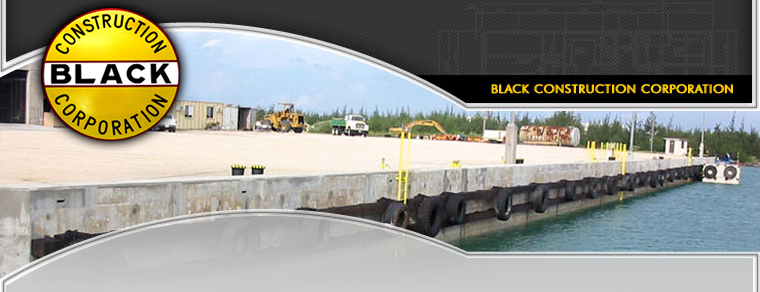Repair Island Access Facilities, Phase I, Wake Island
 This project involved the construction of a new wharf (dock facility) for the Navy (ROICC) located in Wake Island. The work included the installation of new sheet piles and walers with the tie-back system in front of the existing deteriorated sheet piles. The work also included repairs to the existing sheet piles at the existing wharf and causeway, new rain catchment system, septic tank & leaching field to an existing building, cathodic protection for the wharf and causeway and incidental works.
This project involved the construction of a new wharf (dock facility) for the Navy (ROICC) located in Wake Island. The work included the installation of new sheet piles and walers with the tie-back system in front of the existing deteriorated sheet piles. The work also included repairs to the existing sheet piles at the existing wharf and causeway, new rain catchment system, septic tank & leaching field to an existing building, cathodic protection for the wharf and causeway and incidental works.
The project required the construction of a new 130-meter long wharf which included driving of new sheetpiles (PZ-27) in front of the deteriorated sheetpiles. An underwater survey/video was taken along the location of the new sheetpile construction prior to driving of the new sheetpiles. A crane and clamshell were used to clean the sea floor in front of the existing wharf. After cleaning, a re-survey was conducted to make sure all obstructions were removed. Pre-drilling for sheetpile locations commenced thereafter. Driving of the new PZ-27’s followed pre-drilling. Sheetpile driving was accomplished utilizing vibro and diesel hammers to meet required tip elevations.
Construction of a concrete anchor wall for tie-rods was performed as sheetpile driving progressed. Tie-rod installation followed with formwork and placement of reinforcement and concrete for the new bulkhead.
The wharf construction was performed in two phases. Phase 1 was to be completed and turned-over to the Owner before work on Phase 2 could begin. The contract required that half of the existing wharf be operational during the course of the project. Construction activities that could affect the operations of the wharf required coordination with the user in order not to affect operations. Overall construction of the main wharf was completed a month and a half ahead of the planned schedule. The next major item of work involved the repair of the existing sheetpiles for the existing wharf ends and the causeway sheetpiles. Major activities included the welding of new repair plates in front of the existing sheetpiles. The new repair plates were installed within the tidal wave zone. This zone is where most of the sheetpile deterioration occurs. After installation of the repair plates, the repaired sheetpiles had to be sandblasted and painted. Impressed cathodic protection for the new wharf and the existing causeway was installed. Four deep anode wells including rectifiers were also installed.
The biggest challenge if the job, aside from the actual scope of work, was the planning, coordination and shipping of all equipment, tools, materials as well as manpower to Wake Island. Regular shipping operations to Wake Island are non-existent. The channel entry into the harbor is too narrow and very shallow for the use of large vessels; therefore, cargo vessels were restricted in size for safe entry into the harbor. Further, because of the shallow channel, entry into the harbor could only be attempted during high tide and in daylight.
Approximately 6,000 tons of material and equipment for the entire project were transported in three trips to Wake from Guam. Concrete aggregates from Guam including cement from Hanson were loaded onto the chartered barge. Materials shipped from the U.S. would be shipped to Guam then loaded onto the barge for transport to Wake Island. Each barge delivery took approximately 30 per round trip.
Although significant planning was done, the limited flights (once every two weeks) and seating (30 per flight) to Wake Island could have easily impacted the mobilization of personnel and equipment causing additional delays to the overall project. Processing and approval by the Navy / Air Force of entry authorizations and travel orders were required to obtain flight reservations for the mobilization of personnel. Replacement parts in anticipation of equipment failures or breakdowns were a very crucial and essential part of the planning process.
Mobilization for the project was delayed due to the devastation of Guam by Super Typhoon Pongsona. Loading operations for the barge’s first mobilization trip began three (3) days prior to the storm. Due to the impending storm, loading operations were halted and the barge was navigated out to sea. The barge had to be kept away from Guam until the storm ad passed and the Port Authority reopened. However, reopening of the Port was delayed due to a fire at the fuel depot nearby. Overall delay of the project was approximately one and a half months.

Guam Contractors Association 2003 Excellence in Construction Awards
Infrastructure Heavy Category
[hr]
